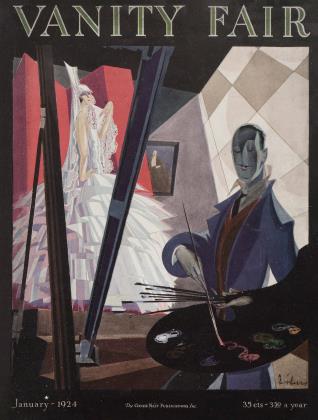Sign In to Your Account
Subscribers have complete access to the archive.
Sign In Not a Subscriber?Join NowThe French Dictate Coming Automobile Tendencies
The Paris Salon Places Approval on Four Wheel Brakes and Balloon Tires
C. S. BISS
WHEN French motor car manufacturers get an idea, they go ahead with it. They are the most commercially courageous makers of automobiles in the world.
They are not bothered by the conservatism which sometimes rises as an obstacle to the progress of mechanical and body design in England. In order to make a revolutionary change in the construction of their cars, they are not confronted by the necessity of spending hundreds of thousands of dollars for factory machinery alterations, as is the case when the great American mass-production car makers wish to introduce something new. The production of standard cars in large quantities is an unknown thing in France, except in the Citroen, and possibly the Voisin, factories. Therefore, it is comparatively a simple matter to introduce a spectacular innovation of motor car engineering or body building, (o try it on the public a while; and, if it does not go, to dismiss it summarily.
Nothing could reveal the temerity of the French manufacturers better than did the recent Salon de l'Automobile, in Paris, where there were more than 840 separate exhibitors of cars and accessories. That exposition forcefully brought out the fact that the French believe themselves natural leaders in matters pertaining to automotive passenger transportation. And, personally, I can see no reason for disputing this leadership on the part of English, American, Italian or German motor car builders, or those of any other country where automobiles are manufactured.
While you in America and we in England are beginning to dabble around with four-wheel brakes, following the lead of Italy and France, the French makers have gone ahead and made their use practically unanimous. Today every car manufactured in France is equipped with front wheel brakes as standard equipment, with the exception of Citroen. And you may be sure that Citroen will have them shortly. The delay has been due to the peculiar construction of the Citroen front axle and the fact that this company is manufacturing according to American mass-production methods. At the Salon there were seventeen or more little cars introduced, all of them lighter than your Ford, and all of them equipped with four-wheel brakes. In other words, the four-wheel brake has definitely arrived in France, as it will arrive in England and America shortly, after the present controversy over the subject in our two countries subsides.
Apparently, the French makers are willing toadopt the balloon tire and give it a fair and impartial opportunity to make good. Although only one French tire manufacturer, Michelin, is making these low pressure balloons, twentyeight makes of cars at the Salon were exhibited with them mounted on special Michelin steel disc wheels. As in the United States, the motor manufacturers are allowing the public to decide the question of balloon tires for itself. Practically all of them are offering the low pressure tires as optional equipment.
Outside of the acceptance of balloon tires and four-wheel brakes, there were very few unusual tendencies revealed at the Salon. Apparently, France is turning its back on the tiny cycle cars and light cars, which have been in vogue for the past few years, and is ready to accept slightly larger machines of 10, 12 and 15 h.p. Great progress has been made in reducing the fuel consumption of cars of this size; and that is really a great consideration in France, where gasoline costs more than sixty cents a gallon and is not always easy to obtain, even at that excessive price. A great many new machines in this medium price class were displayed at the Salon, and their popular use will bridge the gap which formerly existed between the only two classes of motorists which existed in France—the very wealthy with their heavy, fast, expensive cars, and the motorists of moderate means, who were confined more or less to the little cycle cars and light cars, which gave fairly good service, but with a minimum of comfort.
Continued on page 102
Continued from page 71
One of the most interesting new features revealed was a telescopic steering column on the new Fiat, in which the steering gear is mounted behind the dashboard. Another innovation was the Sainsaud de Lavaud transmission, which is sponsored bv the Yoisin Company and is a thing of very radical nature, in that it does away with the ordinary gear set and the present method of transmission. The V-type eight-cylinder engine has been discarded entirely by French makers, in favor of six-cylinder motors and light engines with eight cylinders in line. One very popular tendency at the Show was the adoption of overhead valve engines on a great many of the most popular cars, in place of the L-head motors used formerly. This tendency is in direct contradiction of the present trend in America, where some of your greatest manufacturers are turning from the overhead valve to the L-head type.
American cars represented were those of General Motors, Lincoln and Studebaker. One of the exhibits which attracted attention was that showing of the new Citroen cars, of 5. h.p. and 10 h.p., which had been cut in half from front to rear. A picture of one of these is shown with this article. One might be pardoned for calling these true "coupes". Prices on practically all French cars have gone up from five to ten percent, but the price increases announced at the Show were received favorably by the public, which is beginning to take an increasing intelligent interest in motoring affairs.
 View Full Issue
View Full Issue






Subscribers have complete access to the archive.
Sign In Not a Subscriber?Join Now